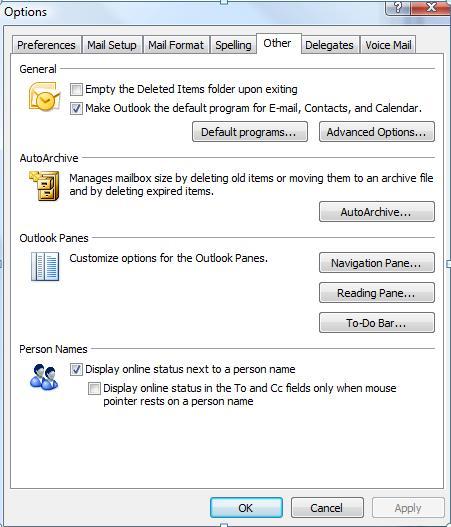Communicator and Exchange – Special considerations for deploying Communicator in an Exchange environment
The Office Communicator team has built a rich set of integration points with both Outlook and Exchange. Communicator Presence can be found throughout Outlook (Presence is the colored bubble that appears next to a person’s name).
In addition, conversation history (as well as missed-call history) is stored in Outlook to allow for a single location to search and review all prior communications. Finally, Communicator obtains calendar and out of office information from Outlook and/or Exchange and uses that information to affect your Presence state.
In order to accomplish these goals, Communicator and Outlook must make additional RPC calls to Exchange. Outlook makes calls in order to resolve a contact’s SIP URI (this is the Communicator ID) for contacts being viewed in mail items. Communicator makes calls to either MAPI or Exchange Web Services to post conversation history and obtain calendar and out of office information.
Calculating how many calls will be made is a tricky effort because it will vary greatly based each specific client configuration and usage pattern. Here is a summary of the RPC calls:
- Outlook: Calls Exchange via MAPI to look up a contact’s SIP URI if it is not already cached or available locally.
- Communicator: Fetches calendar information (free/busy data, meeting subject/time/location and working hours) and Out of Office Note from Exchange. For clients running with Outlook 2007 and Exchange 2007, this information is fetched via Exchange Web Services. Otherwise, it is fetched via MAPI.
- Communicator: stores and retrieves conversation history, missed calls and voicemail via MAPI. (voicemail is only retrieved, not stored)
- Communicator: some contact properties which are not available locally may be retrieved via calls to MAPI (display name, title, office location) and then cached. Communicator does download the Global Address List for an enterprise and synchronize it approximately weekly, so these calls should be minimized.
In the ideal case, if Outlook is running in cached mode and has the full OAB downloaded, there are zero additional RPCs from within Outlook related to IM integration. Communicator would, of course, still be making RPC calls on its own. If Outlook does need to resolve SIP URIs, they are cached. This means that during a single Outlook session, the number of RPCs should, generally, tend to decrease as most of the contacts are cached locally.
If Communicator is not running at all on the client machine, then none of the above applies. These additional RPCs should only occur if Communicator is actually running (just having it installed would not have an effect). In addition, even if Communicator is running, if Presence integration in Outlook is turned off (Tools/Options/Other/Person Names – see image below), then Outlook will not make RPCs to resolve SIP URIs.
-Alex Hehmeyer
PROGRAM MANAGER II
Published Tuesday, January 29, 2008 12:08 PM by octeam
Filed Under: Exchange Integration Category


